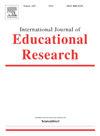Emotion-specificity in emotion regulation: Links to psychosocial and academic functioning in early adolescence
IF 2.5
3区 教育学
Q1 EDUCATION & EDUCATIONAL RESEARCH
引用次数: 0
Abstract
Despite the intimate links between the dysregulation of specific emotions and diagnosis of certain psychopathologies during adolescence, emotion specificity in adolescent emotion regulation remains under-explored. Adopting a person-centered approach, this study identifies profiles of perceived anger, sadness, and worry regulation, and examines how those profiles are related to academic and psychosocial functioning, with a large school sample of early adolescents (45 % female; 47 % male; 4 % non-binary; 31 % sixth grade; 31 % seventh grade; 37 % eighth grade) in the United States. Cluster sampling was conducted. Results from latent profile analysis indicate that a five-profile solution best fits the data: High emotion-general regulation (24.85 %); Average emotion-general regulation (28.57 %); Low emotion-general regulation (12.53 %); Low anger and sadness regulation (25.36 %); and Low worry regulation (8.70 %). Results from latent class modeling (BCH procedure) show that High emotion-general regulation profile has the best outcomes, while Low emotion-general regulation profile has the worst outcomes. Adolescents in the Low anger regulation and Low sadness regulation profile report low persistence and high self-handicapping. Adolescents in the Low worry regulation profile indicate low persistence and high disengagement. Furthermore, female adolescents are under-represented in both Average emotion-general and High emotion-general profiles. Practical implications for understanding and supporting emotion regulation among adolescent students are discussed.
情绪调节中的情绪特异性:与青春期早期的社会心理和学业功能的联系
尽管特定情绪失调与青春期某些精神病理诊断之间存在密切联系,但青少年情绪调节中的情绪特异性仍未得到充分探讨。采用以人为本的方法,本研究确定了感知愤怒、悲伤和担忧调节的概况,并研究了这些概况与学业和社会心理功能的关系,研究对象是美国一所学校的大量早期青少年样本(45%为女性,47%为男性,4%为非二元性,31%为六年级,31%为七年级,37%为八年级)。进行整群抽样。潜在特征分析结果表明,五特征解最适合数据:高情绪-一般调节(24.85%);平均情绪-一般调节(28.57%);情绪-一般调节能力低(12.53%);愤怒和悲伤调节能力低(25.36%);低担忧监管(8.70%)。潜类模型(BCH)结果表明,高情绪-一般调节特征的治疗效果最好,低情绪-一般调节特征的治疗效果最差。低愤怒调节和低悲伤调节的青少年表现出低持久性和高自我设限。低焦虑调节的青少年表现出低坚持和高脱离。此外,女性青少年在“一般情绪”和“一般情绪”方面的代表性都不足。讨论了理解和支持青少年学生情绪调节的实际意义。
本文章由计算机程序翻译,如有差异,请以英文原文为准。
求助全文
约1分钟内获得全文
求助全文
来源期刊

International Journal of Educational Research
EDUCATION & EDUCATIONAL RESEARCH-
CiteScore
6.20
自引率
3.10%
发文量
141
审稿时长
21 days
期刊介绍:
The International Journal of Educational Research publishes regular papers and special issues on specific topics of interest to international audiences of educational researchers. Examples of recent Special Issues published in the journal illustrate the breadth of topics that have be included in the journal: Students Perspectives on Learning Environments, Social, Motivational and Emotional Aspects of Learning Disabilities, Epistemological Beliefs and Domain, Analyzing Mathematics Classroom Cultures and Practices, and Music Education: A site for collaborative creativity.
 求助内容:
求助内容: 应助结果提醒方式:
应助结果提醒方式:


